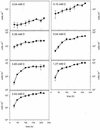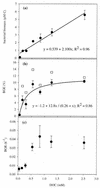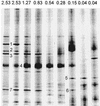Heterotrophic bacterial growth efficiency and community structure at different natural organic carbon concentrations
- PMID: 12839735
- PMCID: PMC165184
- DOI: 10.1128/AEM.69.7.3701-3709.2003
Heterotrophic bacterial growth efficiency and community structure at different natural organic carbon concentrations
Abstract
Batch cultures of aquatic bacteria and dissolved organic matter were used to examine the impact of carbon source concentration on bacterial growth, biomass, growth efficiency, and community composition. An aged concentrate of dissolved organic matter from a humic lake was diluted with organic compound-free artificial lake water to obtain concentrations of dissolved organic carbon (DOC) ranging from 0.04 to 2.53 mM. The bacterial biomass produced in the cultures increased linearly with the DOC concentration, indicating that bacterial biomass production was limited by the supply of carbon. The bacterial growth rate in the exponential growth phase exhibited a hyperbolic response to the DOC concentration, suggesting that the maximum growth rate was constrained by the substrate concentration at low DOC concentrations. Likewise, the bacterial growth efficiency calculated from the production of biomass and CO(2) increased asymptotically from 0.4 to 10.4% with increasing DOC concentration. The compositions of the microbial communities that emerged in the cultures were assessed by separation of PCR-amplified 16S rRNA fragments by denaturing gradient gel electrophoresis. Nonmetric multidimensional scaling of the gel profiles showed that there was a gradual change in the community composition along the DOC gradient; members of the beta subclass of the class Proteobacteria and members of the Cytophaga-Flavobacterium group were well represented at all concentrations, whereas members of the alpha subclass of the Proteobacteria were found exclusively at the lowest carbon concentration. The shift in community composition along the DOC gradient was similar to the patterns of growth efficiency and growth rate. The results suggest that the bacterial growth efficiencies, the rates of bacterial growth, and the compositions of bacterial communities are not constrained by substrate concentrations in most natural waters, with the possible exception of the most oligotrophic environments.
Figures





Similar articles
-
Dissolved organic matter concentration and quality influences upon structure and function of freshwater microbial communities.Microb Ecol. 2006 Oct;52(3):378-88. doi: 10.1007/s00248-006-9089-x. Epub 2006 Jun 10. Microb Ecol. 2006. PMID: 16767520
-
Bacterial community structure and physiological state within an industrial phenol bioremediation system.Appl Environ Microbiol. 2000 Jun;66(6):2400-7. doi: 10.1128/AEM.66.6.2400-2407.2000. Appl Environ Microbiol. 2000. PMID: 10831417 Free PMC article.
-
Bacterioplankton community shifts in an arctic lake correlate with seasonal changes in organic matter source.Appl Environ Microbiol. 2003 Apr;69(4):2253-68. doi: 10.1128/AEM.69.4.2253-2268.2003. Appl Environ Microbiol. 2003. PMID: 12676708 Free PMC article.
-
Effect of exposure to sunlight and phosphorus-limitation on bacterial degradation of coloured dissolved organic matter (CDOM) in freshwater.FEMS Microbiol Ecol. 2008 May;64(2):230-9. doi: 10.1111/j.1574-6941.2008.00449.x. Epub 2008 Feb 26. FEMS Microbiol Ecol. 2008. PMID: 18312374
-
The microbial carbon pump: from genes to ecosystems.Appl Environ Microbiol. 2011 Nov;77(21):7439-44. doi: 10.1128/AEM.05640-11. Epub 2011 Aug 26. Appl Environ Microbiol. 2011. PMID: 21873483 Free PMC article. Review.
Cited by
-
Diversity and putative metabolic function of prokaryotic communities in tank bromeliads along an elevation gradient in tropical Mexico.Front Microbiol. 2022 Oct 13;13:945488. doi: 10.3389/fmicb.2022.945488. eCollection 2022. Front Microbiol. 2022. PMID: 36312956 Free PMC article.
-
Transplant experiments uncover Baltic Sea basin-specific responses in bacterioplankton community composition and metabolic activities.Front Microbiol. 2015 Apr 1;6:223. doi: 10.3389/fmicb.2015.00223. eCollection 2015. Front Microbiol. 2015. PMID: 25883589 Free PMC article.
-
Spatiotemporal variation of bacterial community composition and possible controlling factors in tropical shallow lagoons.Microb Ecol. 2010 May;59(4):819-29. doi: 10.1007/s00248-010-9642-5. Epub 2010 Mar 9. Microb Ecol. 2010. PMID: 20217404
-
Dispersant Enhances Hydrocarbon Degradation and Alters the Structure of Metabolically Active Microbial Communities in Shallow Seawater From the Northeastern Gulf of Mexico.Front Microbiol. 2019 Oct 18;10:2387. doi: 10.3389/fmicb.2019.02387. eCollection 2019. Front Microbiol. 2019. PMID: 31749769 Free PMC article.
-
Occurrence and Succession of Bacterial Community in O3/BAC Process of Drinking Water Treatment.Int J Environ Res Public Health. 2019 Aug 27;16(17):3112. doi: 10.3390/ijerph16173112. Int J Environ Res Public Health. 2019. PMID: 31461864 Free PMC article.
References
-
- Altschul, S. F., W. Gish, W. Miller, E. W. Myers, and D. J. Lipman. 1990. Basic local alignment search tool. J. Mol. Biol. 215:403-410. - PubMed
-
- Amon, R. M. W., and R. Benner. 1996. Bacterial utilization of different size classes of dissolved organic matter. Limnol. Oceanogr. 41:41-51.
-
- Ausubel, F. M., R. Brent, R. E. Kingston, D. D. Moore, J. G. Seidman, J. A. Smith, and K. Struhl. 1998. Current protocols in molecular biology, vol. 4, unit 2.5. John and Sons, Wiley, New York, N.Y.
-
- Bano, N., M. A. Moran, and R. E. Hodson. 1997. Bacterial utilization of dissolved humic substances from a freshwater swamp. Aquat. Microb. Ecol. 12:233-238.
-
- Bertilsson, S., and L. J. Tranvik. 2000. Photochemical transformation of dissolved organic matter in lakes. Limnol. Oceanogr. 45:753-762.
Publication types
MeSH terms
Substances
Associated data
- Actions
- Actions
- Actions
- Actions
- Actions
- Actions
- Actions
- Actions
- Actions
- Actions
- Actions
- Actions
- Actions
- Actions
LinkOut - more resources
Full Text Sources
Other Literature Sources
Molecular Biology Databases

